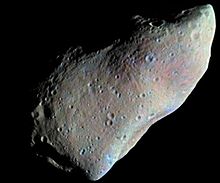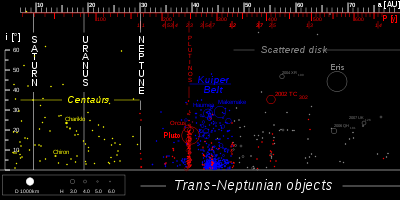- Small Solar System body
-
 951 Gaspra, a small Solar System body in the asteroid belt, measuring about 18 km in length (photographed by the Galileo probe)
951 Gaspra, a small Solar System body in the asteroid belt, measuring about 18 km in length (photographed by the Galileo probe)
A small Solar System body (SSSB) is an object in the Solar System that is neither a planet nor a dwarf planet, nor a satellite of a planet or dwarf planet:[note 1]
All other objects, except satellites, orbiting the Sun shall be referred to collectively as "Small Solar System Bodies" ... These currently include most of the Solar System asteroids, most Trans-Neptunian Objects (TNOs), comets, and other small bodies.[1]This encompasses all comets and all minor planets other than those classified as dwarf planets, i.e.:
- the classical asteroids, with the exception of Ceres;
- the centaurs and trojans;
- the trans-Neptunian objects, with the exception of Pluto, Haumea, Makemake and Eris;
The term was first defined in 2006 by the International Astronomical Union.
It is not presently clear whether a lower size bound will be established as part of the definition of small Solar System bodies in the future, or if it will encompass all material down to the level of meteoroids, the smallest macroscopic bodies in orbit around the Sun. (On a microscopic level there are even smaller objects such as interplanetary dust, particles of solar wind and free particles of hydrogen.)
Except for the largest, which are in hydrostatic equilibrium, moons differ from small Solar System bodies not in size, but in their orbits. Moons' orbits are not centered around the Sun but around other Solar System objects such as planets, dwarf planets, and even small Solar System bodies themselves.
Some of the larger small Solar System bodies may be reclassified in future as dwarf planets, pending further examination to determine whether or not they are in hydrostatic equilibrium.
The orbits of the vast majority of small Solar System bodies are located in two distinct areas, namely the asteroid belt and the Kuiper belt. These two belts possess some internal structure related to perturbations by the major planets (particularly Jupiter and Neptune, respectively), and have fairly loosely defined boundaries. Other areas of the Solar System also encompass small bodies in smaller concentrations. These include the near-Earth asteroids, centaurs, comets, and scattered disc objects.
See also
- List of Solar System objects by size
- Apollo asteroid
- Asteroid belt
- Centaur (minor planet)
- Comet
- Cybele asteroid
- Hilda family
- Hungaria family
- Kuiper belt
- Lists of Small Solar System Bodies
- List of gravitationally rounded objects of the Solar System
- List of dwarf-planet candidates
- Meteoroid
- Near-Earth asteroid
- Trojan asteroid
- Trans-Neptunian object
- Vulcanoid asteroid
Notes
- ^ The formally correct typography for common nouns such as "small Solar System bodies" and "trans-Neptunian objects" is sentence case, rather than title case as used by the IAU in this instance.
References
Small Solar System bodies Minor planets - Designation
- Groups
- Moons
- Meanings of names
- Pronunciation of names
Comets Meteoroids Lists / categories - Asteroid groups and families
- Asteroid moons
- Binary asteroids
- Minor planets
Categories:- Minor planets
Wikimedia Foundation. 2010.

